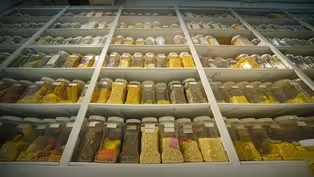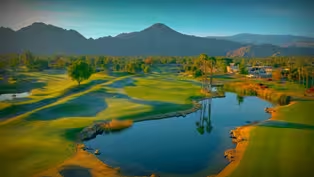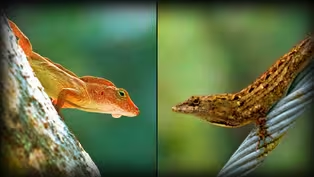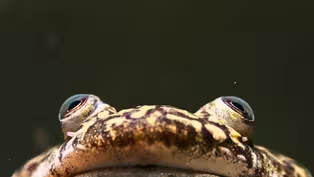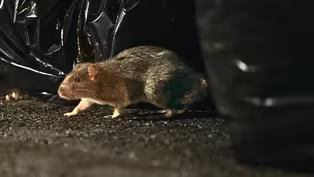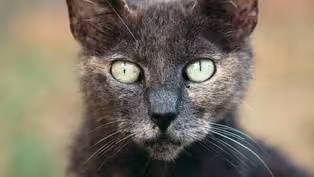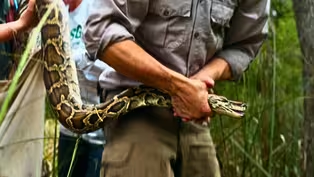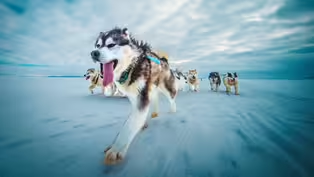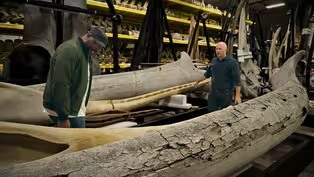
How An Ancient Ocean Shaped Us History
Special | 16m 54sVideo has Closed Captions
Learn how millions of years of deposits shaped the events of Black American history.
From ancient seas to fertile soils, evolutionary biologist Shane Campbell-Staton explores the remarkable journey that transformed the Cretaceous coastline into the fertile “Black Belt” region of the American South. He joins oceanographer Craig McClain, professor Sven Beckert, and geneticist Steven Micheletti to learn how millions of years of deposits shaped the events of Black American history.
Problems playing video? | Closed Captioning Feedback
Problems playing video? | Closed Captioning Feedback

How An Ancient Ocean Shaped Us History
Special | 16m 54sVideo has Closed Captions
From ancient seas to fertile soils, evolutionary biologist Shane Campbell-Staton explores the remarkable journey that transformed the Cretaceous coastline into the fertile “Black Belt” region of the American South. He joins oceanographer Craig McClain, professor Sven Beckert, and geneticist Steven Micheletti to learn how millions of years of deposits shaped the events of Black American history.
Problems playing video? | Closed Captioning Feedback
How to Watch Human Footprint
Human Footprint is available to stream on pbs.org and the free PBS App, available on iPhone, Apple TV, Android TV, Android smartphones, Amazon Fire TV, Amazon Fire Tablet, Roku, Samsung Smart TV, and Vizio.
Buy Now

Surprising Moments from Human Footprint
Do you think you know what it means to be human? In Human Footprint, Biologist Shane Campbell-Staton asks us all to think again. As he discovers, the story of our impact on the world around us is more complicated — and much more surprising — than you might realize.Providing Support for PBS.org
Learn Moreabout PBS online sponsorshipMore from This Collection
Video has Closed Captions
Watch the rise of a productive crop that has managed to replace itself, but at what cost? (11m 24s)
The Watery Price Of Golf Courses & Lawns
Video has Closed Captions
The cultural and resource costs for manicured lawns and golf courses are quite shocking. (11m 29s)
How Dogs Are Shaping The Future Of Medicine
Video has Closed Captions
Observe the rich diversity of dog breeds, shaped by genes and human intervention. (12m 43s)
We Brought This Fish To America. Now We Can't Get Rid Of It
Video has Closed Captions
Expose Asian carp for disrupting native fish species and shrinking their populations. (10m 39s)
Why Are These Urban Lizards Evolving in Overdrive?
Video has Closed Captions
Examine city-dwelling anoles with remarkable evolutionary changes. (10m 33s)
Video has Closed Captions
What happens when frogs become indispensable? (8m 59s)
Video has Closed Captions
When it comes to NYC, the rat is the undisputed king! (13m 26s)
Your Cat’s Secret Life (as a Deadly Predator)
Video has Closed Captions
Cats have been winning the hearts of humans for years....but can devastate ecosystems. (10m 40s)
Singapore: Designing a Megacity in Harmony with Nature
Video has Closed Captions
Green spaces aren't just an afterthought here - they're mandatory! (13m 24s)
How Giant Pythons Became Florida’s Biggest Invasive Species
Video has Closed Captions
Ever heard of the phrase "when pet pythons outgrow their owners"? (13m 24s)
Sled Dogs: The Most Extreme Distance Athletes on Earth
Video has Closed Captions
In the Arctic, it's not just about muscle power, but brainpower too. (15m 17s)
Secrets of the World’s Only Whale Warehouse
Video has Closed Captions
Uncover the history of whaling and its impact on our oceans. (9m 58s)
Providing Support for PBS.org
Learn Moreabout PBS online sponsorshipBasically what we're…what we’re looking at is a massive graveyard.
It's the ghost of oceans past, essentially.
I’ve never seen anything like this before.
Picture this: a hundred million years ago, a lot of the Southern U.S. was underwater.
The geology created by this ancient ocean played a starring role in the story of cotton…and as a result, in the events that shaped African American history.
How did ancient rocks shape the legacy of slavery in our not-so-distant past, and how are these stories being revealed today through modern science?
I’m evolutionary biologist Shane Campbell-Staton, and this is Human Footprint.
Exactly what is it that I'm looking at here?
Yeah, you're seeing a million and a half years here.
Wow.
That's a lot of history.
This is biological oceanographer, Craig McClain.
Think of a ridiculously oversized roadside attraction and, well, Craig’s probably taken a selfie with it.
But in his day job, Craig studies some of the smallest creatures in the ocean.
So let's go back to about 135 million years ago.
We're at the beginning of the Cretaceous period.
So at this time, the climate’s warm.
And so the polar ice caps are melted.
This is all what we call shallow seas.
Okay so the Gulf extended much farther inland back then.
That's right.
Oh, very much so.
We would be a couple hundred feet underwater.
And so that caused a lot of plankton production in the waters near the coast.
And among those plankton were microscopic algae with calcium carbonate shells.
There's so many of them that the zooplankton can't eat them fast enough.
So a lot of it's just sinking to the sea floor.
Over millions of years, layer upon layer of those tiny shells were compressed under their own weight into chalk.
Every foot that you see there is about 18,000 years.
What happens here is this is so packed and so dense that it doesn't allow water to drain out of this.
After the Cretaceous seas retreated, this region became grasslands.
And for millions of years, decomposing plants and the nutrients they contained built up on top of the chalk layer.
The result?
A band of super-productive soils that traces the ancient coastline.
That is what's known as the Black Belt because of these dark, rich, organic soils that are now at the surface and have led to plant and crop production.
There’s a lot more cotton production, and it could be 10 to 20 times greater than the adjacent counties outside of this region.
And so that meant that there was more enslaved people to work those plantations in those areas.
It’s kinda hard to wrap my head around…Thinking about the events of African American history being shaped by deposits of millions of years of dead microorganisms.
That's crazy.
The planet may have set the stage for what would happen next, but the story of cotton was written by people and the decisions they made.
[phone ringing] Hello?
Hey, Sven.
How's it going, man?
Good, good, good.
How are you, Shane?
Even on sabbatical in Florence, Italy, Sven can’t stop thinking about the roots of global capitalism.
He’s written an award-winning book on the subject, and at the heart of the story is cotton.
You walk into a store and you can buy a t-shirt for a few dollars…you can buy a pair of jeans for a few more dollars.
It's almost like the air we breathe.
But this white fluffy fiber, once we start looking into its history, it allows us to understand how the world in which we live in today came into being, with all of its possibilities and with all of its problems.
By the late 18th century, the French Caribbean colony of Saint-Domingue – present-day Haiti – was the world’s top producer of raw cotton.
But in 1791, enslaved African workers revolted and overthrew the government, essentially bringing cotton production to a halt… And creating an economic opportunity for the new United States of America.
The moment when cotton comes to the United States, and when the United States becomes important to cotton…is the early 1790s.
Just two years after the Haitian Revolution, American inventor Eli Whitney designed the first mechanical cotton gin, a machine that could process cotton fifty times more efficiently than a human worker.
Whitney genuinely believed his invention would reduce the demand for slave labor.
But the efficiency of the cotton gin actually made cotton far more profitable, fueling the expansion of the plantation system across the South, particularly on the ancient coastline that formed the Black Belt.
In the United States, planters…they were politically very powerful.
And so, they could deploy the Federal Government to both remove indigenous people and also to force enslaved Africans to work in cotton agriculture.
This is the moment then that the United States becomes the most important producer of raw cotton for global market and the most important supplier of raw cotton to European industry.
The stories of the enslaved people whose labor powered this industry are recorded in bits and pieces in written and oral histories.
But the legacy of slavery is also written into our very DNA.
Ancestry is kind of a vague term because if we go far enough back, we all have the same ancestor.
Steven Micheletti is a geneticist at the consumer genetic testing company 23andMe.
I started off my career looking at actually reptiles and amphibians before moving on to fish, then moving on to humans.
That's a pretty big jump.
What prompted the change?
I started studying migrations using population genetics.
And that brought me here where we have the opportunity, using a lot of study participants' data, to look at these widespread migrations across the continents.
When people move from place to place, they take their DNA with them and pass it on to their children.
So researchers like Steven can use DNA to explore human migrations…like the forced migration of the slave trade.
We were interested in studying Africa because we knew this was going to be impactful for many people.
For a lot of Black Americans, myself included, it’s hard to know exactly where our ancestors came from, how they got here, and when.
But our genes can tell us stories that aren’t recorded anywhere else.
Close family members have a lot of DNA that is identical.
So it's easy to figure out the relationship between two closely related people.
But with technology today, we can actually go further down the family tree.
Now we can actually infer these distant relationships that occurred 400 to 500 years ago.
Genetic data from 50,000 research participants revealed patterns that, in many cases, supported written histories of the Transatlantic slave trade.
If we focus specifically on the historical records, we know that the primary source of enslaved people was West Central Africa, where 5.7 million individuals were taken.
If we look on the genetic side, we see that most people living in the Americas have genetic connections to West Central Africa.
So that's pretty intuitive.
More people were being taken from West Central Africa, more people in the Americas today have genetic connections to that region.
But the genetic data also show that the Transatlantic slave trade was only part of the story.
Importing enslaved people from Africa was outlawed in 1808.
But slavery continued, supported by a domestic slave trade, through which more than a million enslaved people were forced to migrate from the Upper South – states like Virginia and Maryland – to the Deep South, where cotton was booming.
And that left a signature in the DNA, too.
The group of people that were impacted the most were the Igbo from Nigeria.
Probably as a result we see that a lot of African-Americans today have connections to the Igbo people.
They have a lot of Nigerian ancestry.
Most Black Americans also have some ancestry from Europe.
And the details paint a troubling picture.
In general, genetic males have an X and a Y chromosome, and genetic females have two X chromosomes.
So we can look specifically at ancestry on these sex chromosomes to determine where the maternal or paternal line originated from.
And one of the disturbing things we found is, in most cases, people of African descent have a European paternal line and an African maternal line.
And over 60% of people taken from Africa were men, yet we're seeing this female bias in people today.
What story does this tell us?
It tells us about exploitation of enslaved African women.
And it tells us that, to be blunt, they were being raped.
We wouldn't see this pattern any other way…And we know that slavers were taking advantage of enslaved women.
These genetic data confirm it.
And centuries later, millions of us still carry the evidence of our ancestors’ trauma in our DNA.
For Steven, delving into his own family’s DNA came with some unsettling discoveries, too.
Let's start by looking at the ancestry composition report.
And this is actually for my grandfather who recently passed away.
We found that his maternal haplogroup, which is his maternal genetic line, actually assigned directly to this L3F1B.
This is uncommon among 23andMe customers, but we know that it's very frequent in African populations.
And for me, what this means is, I know his grandparents came from the Carolinas.
It's likely that somewhere along the line in our family history we had a slave owner, and at some point they reproduced with likely an African enslaved women, and we have African DNA in our genome because of this.
Now, when you saw these results, does it change your understanding of yourself in any way?
This is telling the tale of my family's history that I didn't know about, and it is deeply disturbing.
I welcome diversity in my genome.
I think that's great.
I just don't like how it got there.
Yeah, yeah.
Yeah, I can understand that.
Our identities certainly aren’t determined by our genes alone.
But they’re not disconnected from our genes, either.
I mean, one of the things that drew me to science in the first place, this idea of reading the story of DNA, it's just a very powerful idea to me.
Something that really captivated me and still captivates me today.
But there's something a lot more intimate and personal about talking about the genetic and biological legacy of slavery in the US.
And all of those things are intertwined both culturally, but literally intertwined in the fundamental building blocks that make up my cells.
It’s just closer.
It’s like this part of the human footprint is me, which is not something that I think about a lot.
Of course, DNA isn’t the only way you can still see the legacy of slavery.
It’s also part of our politics.
Craig McClain brought the data to show me the connection.
So this is a geologic map.
The different colors here sort of represent different types of rocks and rock formations, right?
And what you can see here is this green band is that sort of limestone chalk.
That we were standing on.
This is what eventually becomes the belt.
That's right.
That is the sort of chalk deposits that begin the Black Belt.
And you can see faintly here, this line in here, that's that… Same band.
That same band, this is cotton production.
Each one of those dots represents about 10,000 bushels of cotton.
And this is the percentage of enslaved people.
And you can see that in some places it's quite high…50 to 75% throughout that band.
And of course as you go further north and further south, those percentages really begin to drop off.
This is harder to look at than I thought it would be.
I can imagine so.
Yeah.
So where do we go from here?
So this is more recently, and this is the black population by county through the South.
It is the same band over and over again.
It's the same.
So once those enslaved people were freed, a lot of them stayed in those same regions.
How do these demographics then translate into politics?
Okay, so this is the 2008… Oh my god.
…presidential election.
And so it's that same band, right?
African Americans on average, typically vote Democratic.
And so in these cases, in a sea of Republican counties that are Republican-dominated, these counties often vote primarily Democratic.
This is crazy.
This is crazy.
Right, and it continues to play out.
So this is the recent 2020 election.
Wow.
So it continues to play out over and over and over again.
I've never seen anything like this before.
The patterns Craig is showing me only appeared after 1965, when the Voting Rights Act was signed into law.
So after that, we start to see it coming in faintly.
And then every presidential election it gets stronger and stronger and stronger and patterned until the last two to three decades, where it has been a prominent feature of every election.
In other words, each time the U.S. holds an election, a blue wave crashes ashore on that ancient coastline that cuts across the American South.
Oh my god, the idea that there's a single through line that links piles of dead Cretaceous organisms to voting patterns across geographic space, is phenomenal.
I've just literally never seen anything like this before.
When I sort of heard about this, I really went out and searched for the maps and kept finding more and more patterns that reflected that.
The places we live – and even the soil under our feet – make a certain set of histories possible.
But they don’t make any one history inevitable.
It's one thing to have, here in Alabama, to sit on fertile soil.
I mean just because these soils were here does not mean that slavery had to happen.
There’s no question the world we live in leaves its footprint on us.
But the impacts we have on the planet, and each other?
Those are on us, and the choices we make.
Thanks for watching!
If you want more Human Footprint, you can tune in to the full length series on the PBS App or on your local PBS station.

- Science and Nature

Explore scientific discoveries on television's most acclaimed science documentary series.

- Science and Nature

Capturing the splendor of the natural world, from the African plains to the Antarctic ice.












Support for PBS provided by:
